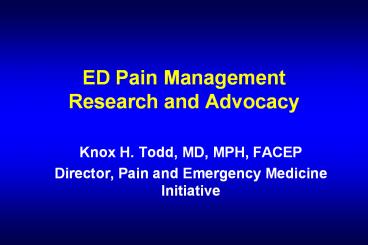ED Pain Management Research and Advocacy - PowerPoint PPT Presentation
1 / 25
Title:
ED Pain Management Research and Advocacy
Description:
ED Pain Management. Research and Advocacy. Knox H. Todd, MD, MPH, FACEP ... American Geriatrics Society Guideline on the Management of Persistent Pain in ... – PowerPoint PPT presentation
Number of Views:53
Avg rating:3.0/5.0
Title: ED Pain Management Research and Advocacy
1
ED Pain ManagementResearch and Advocacy
- Knox H. Todd, MD, MPH, FACEP
- Director, Pain and Emergency Medicine Initiative
2
SWOT Analysis
- Strengths
- Pain prevalence and severity
- Momentum of efforts
- Opportunities
- Novel therapies
- National initiatives
- Weaknesses
- Inferior education
- Failing academic business model
- Threats
- Resources
- Industry marketing forces
3
Strengths
- Increasing recognition
- High prevalence of pain
- High levels of pain intensity
- Increasing number of collaborators
- Increasing number of activities
4
EM Pain Literature
Medline Search by Year of Publication Pain and
Emergency Medicine
5
ED Analgesia Use 1997 2001
National Hospital Ambulatory Care Survey Data
ED Summary. NCHS 2001.
6
Weaknesses
- Lack of training
- Scarcity of mentors
- Cracks in the peer review process
- Inferior resident and continuing education
- Large service demands
- Failing academic business model
7
Education
- From Emergency Medicine, 6th Edition
(Tintinalli, page 565) - Patients presenting with biliary colic and
emesis are best treated with antispasmodic agents
(glycopyrrolate), - Meperidine is the analgesic of choice because it
produces significantly less spasm of the
sphincter of Oddi
8
Opportunities
- New therapeutic modalities
- National initiatives
- Pain and Emergency Medicine Initiative
9
JCAHO Standards
- Patients have the right to appropriate assessment
and management of pain - Patients can expect
- that reports of pain will be believed
- information about pain and pain relief measures
- that staff will be concerned
- that health professionals will respond quickly
- to receive effective pain management
Comprehensive Accreditation Manual for Hospitals.
JCAHO. 1999.
10
ACEP Pain Policy - 2004
- ED patients should receive expeditious pain
management. - Hospitals should develop unique strategies that
will optimize ED patient pain management. - ED policies and procedures should support the
safe utilization and prescription writing of pain
medications. - Effective physician and patient educational
strategies should be developed. - Ongoing research in the area of ED patient pain
management should be conducted.
Ann Emerg Med. 200444198.
11
Organized Support for Pain Treatment
- National Organizations Issue Guideines
- U.S. Agency for Health Care Policy and Research
(AHCPR)1992 - U.S. Department of Health and Human Services1994
- AAPM/APS Consensus Statement1996
- American Society of Anesthesiologists1997
- WHO FSMB1998
- AMA APS (sickle-cell anemia)1999
- American Pain Society Clinical Guideline for
Arthritis2002 - State-Led Initiatives
- Legislation in form of Intractable Pain Acts (gt10
states by 1999) - Guidelines for pain management (gt18 states by
1999) - State Cancer Pain Initiatives
(AAPM/APS, 1996 AMA, 2001 ASA, 1997 FSMB,
1998 JCAHO, 1999 WHO, 1996)
12
Guidelines
- Wisconsin Medical Societys Guidelines for the
Assessment and Management of Chronic Pain (2004) - http//www.wisconsinmedicalsociety.org/uploads/wmj
/pain_manageguides.pdf - American Geriatrics Society Guideline on the
Management of Persistent Pain in Older Persons
(2002) - http//www.americangeriatrics.org/products/positio
npapers/JGS5071.pdf
13
APS Clinical Practice Guidelines Program
Comprehensive, evidence-based, peer-reviewed
To order http//www.ampainsoc.org/pub/infoform.ht
m
14
Principles of Analgesic Use in the Treatment of
Acute Pain and Cancer Pain
- APS, 5th Edition (2003)
- Compiled and written by a committee of experts
- Up-to-date information on how to use recently
approved analgesics - http//www.ampainsoc.org/pub/principles.htm
15
APS Annual Scientific Meeting
- 2005 - 24th Annual APS MeetingHynes Convention
CenterBoston, MAMarch 29-April 4, 2005
16
APS EM Scholars
- 2003
- Cameron S. Crandall
- David Fosnocht
- Sam McLean
- Martha Neighbor
- Basmah Safdar
- 2004
- Mary Ann Cooper
- Matt Lewin
- Barbara Lock
- John McManus
- Gerard Rebegliati
- Scott Rohrbeck
- Sachin Shah
- Leslie Zun
17
Mayday Pain Society FellowshipA Media Policy
Initiative
- Goals and content
- train advocates for change
- 18 fellows over three years
- communications and leadership training in
Washington DC - work with communications professionals to develop
strategies - commit 10 percent time over a 6 month period
- develop a communications strategic plan
- Goal possibilities include
- Advancing the pain management in your institution
- Educating patients and the public about pain
treatment Educating the public about alternative
to medications - Developing improved pain management curriculum
- Educating the public about pain
18
Threats
- Marketing forces
- Lack of financial support
- Lack of FDA/JCAHO involvement
- Lack of creative research
19
Lack of Federal Funding
- Although pain costs the United States 79
billion annually in lost productivity and results
in more than 20 of visits to all physicians and
70 of visits to EDs, only 0.6 of the current
National Institutes of Health budget is devoted
to basic and clinical pain research.
Todd KH. Ann Emerg Med. 200443504-506.
20
The Pain and Emergency Medicine Initiative
- Supported by The Mayday Fund
- through a grant to
- The Emergency Medicine Foundation
21
Pain Intensity
22
Time to Analgesic
- Total ED time (triage to discharge) Mean 192
minutes Median 159 minutes - Time to first analgesic (triage to
analgesic) Mean 110 minutes Median 88
minutes
23
Assessment
- Proportion receiving initial ED pain
assessment 79 - Proportion receiving gt1 ED pain assessment
17
24
Chronic Pain and the ED
- 134 subjects (44) with chronic pain
- Median duration of symptoms - 2 years reporting
at least 1 ED visit within the past
year Chronic Pain 79 No Chronic Pain
40Mean ED visits per person within past
year Chronic Pain 4.3 No Chronic Pain 1.3
25
Healthcare Utilization
26
Pain-related Functional Interference































